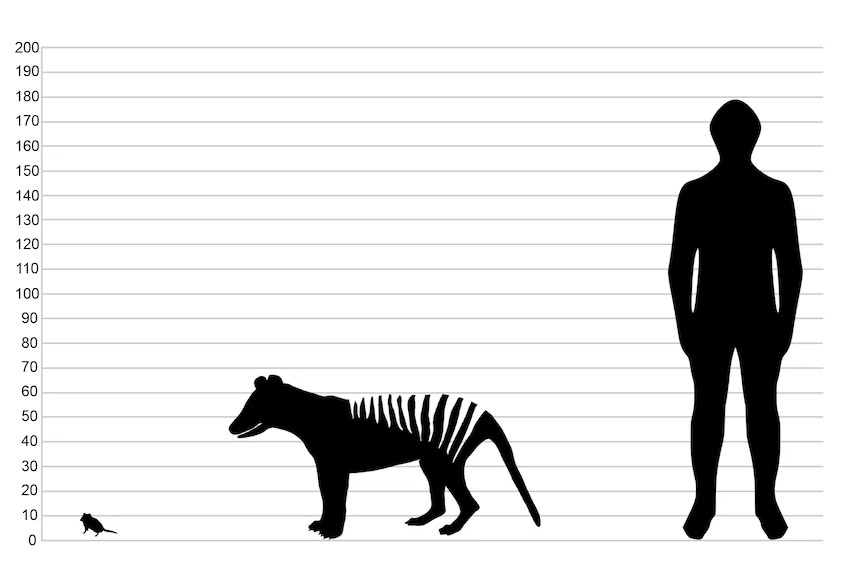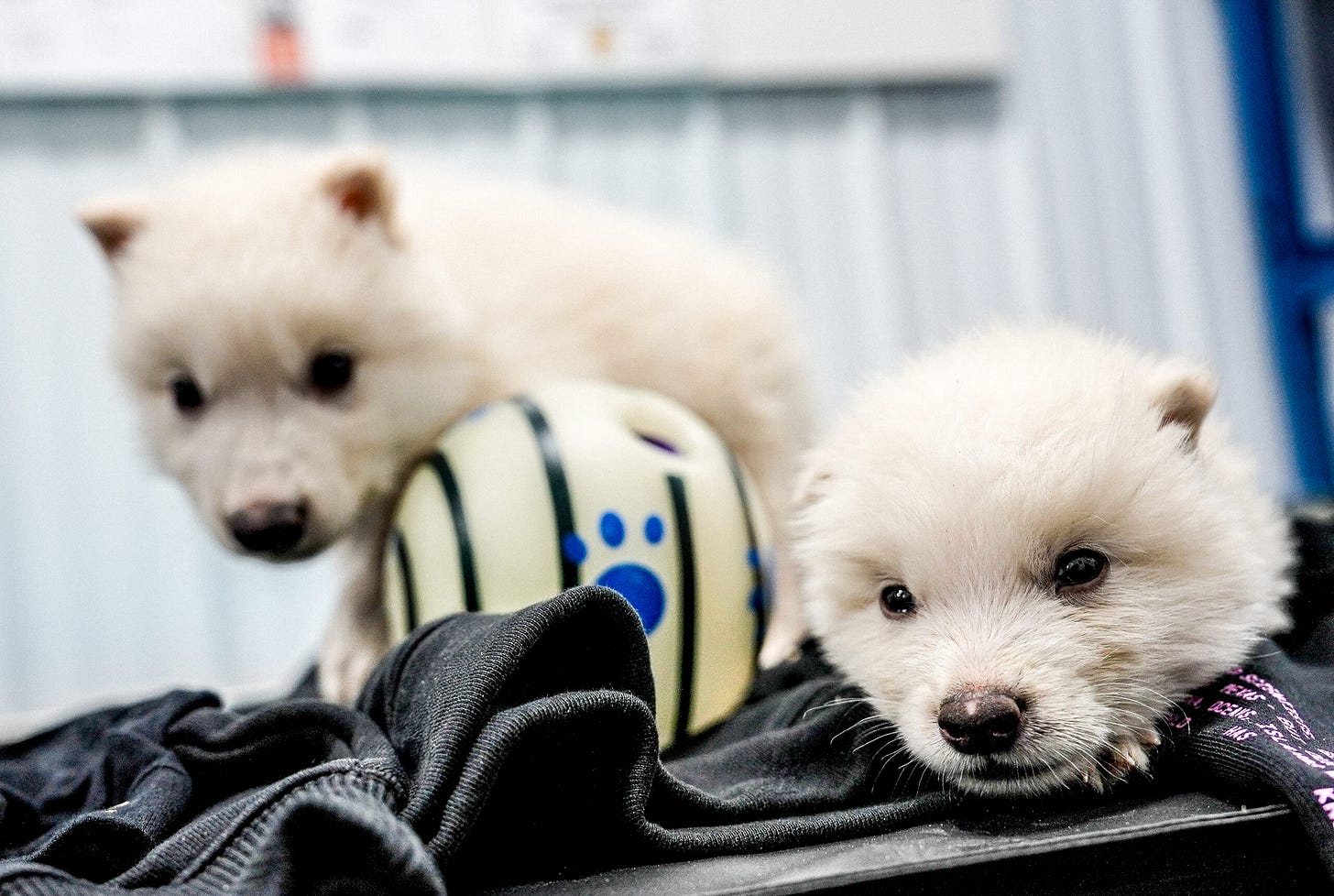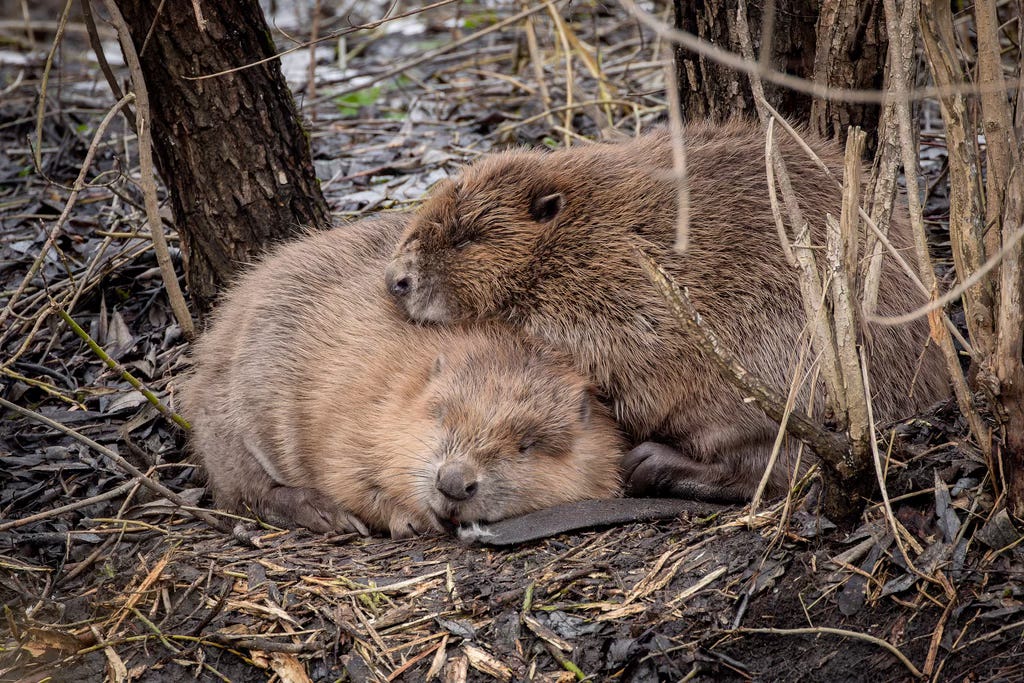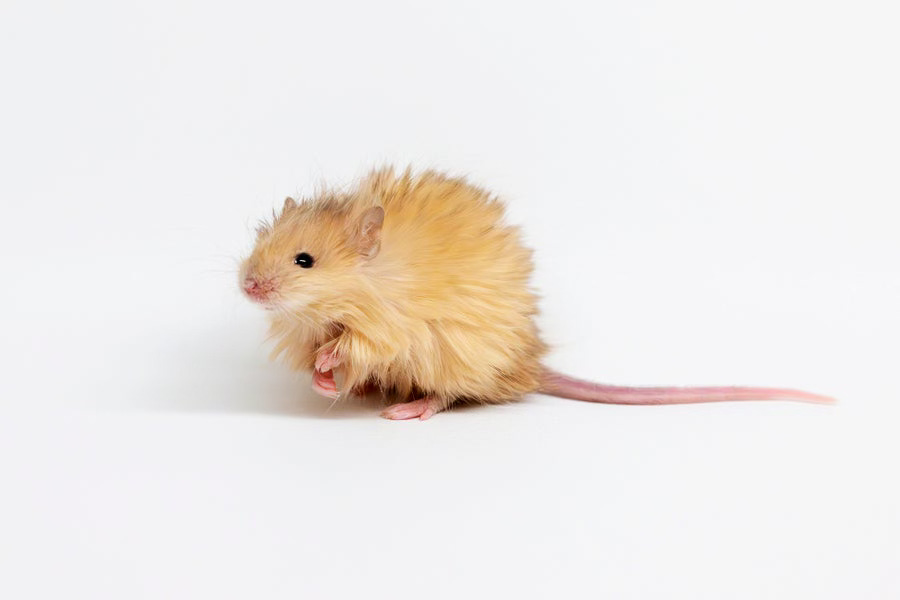Big Hairy Audacious Goals
Unpacking de-extinction, Colossal, and the planet’s three new dire wolves.
🪸 We’re Superorganism, the first VC for startups that benefit biodiversity. Each month we publish thoughts from the frontline, company updates, and a round-up of new happenings in the nature tech world.
What a month it’s been for using technology to better decode and understand the natural world.
Deep in the south Atlantic ocean, the underwater ROV SuBastian recorded the first-ever live footage of a colossal squid, a near-legendary animal known largely from dying individuals and remains in bird and whale carcasses.
In cyberspace, Google and the Wild Dolphin Project released Dolphin Gemma, an LLM to decode dolphin communication.
From 124 light years away, the James Webb Space Telescope detected the chemical signature for dimethyl sulfide on the water-logged exoplanet K2-18 b. On Earth, dimethyl sulfide is exclusively produced by living organisms like algae. If that holds true on K2-18 b as well (more on that “if” here), then this month brought our strongest proof yet that life exists elsewhere in the universe.
But squids, interspecies communication, and intergalactic distances weren’t the only colossal topics this month. There was also Colossal, which in April made two signature announcements: that it had successfully created dire wolves, and that it had also cloned red “ghost” wolves.
In light of this news, this month we’re diving into the hot button topic du jour: de-extinction. Grab a coffee and settle in, this is a long one.
Extinction: a short history
The idea of extinction, where a once-present species has been completely wiped out, is a surprisingly recent one. In the 17th century geologists had found and documented fossils like giant antlers (from the great Irish elk Megaloceros) and massive nautilus shells, but hypothesized they were from populations that existed in corners of the world yet “unexplored.”
Only in 1796 did George Cuvier first propose there were some species that no longer existed, when he shared fossil mammoth skulls found just outside of Paris with an audience. He documented the skull’s differences from Asian and African elephants’, and reasoned that such large animals could not escape so long undetected in Europe.
The idea of permanent extinction didn’t take off immediately. In the early days of the United States, where naturalists had also found mammoth fossils, Thomas Jefferson hoped the Lewis and Clark expedition might return with evidence of a great American elephant population. (They did not).
Parallel trends helped the idea of extinction take hold: the continued discoveries of increasingly fantastic fossils like dinosaurs and marine reptiles throughout the 1700s and 1800s, the real-time, well-documented elimination of species like dodo birds in Mauritius, and ultimately Darwin’s theory of evolution by natural selection, which helped place these lost species into a context of life on earth.
While our understanding of extinction is recent, these losses aren’t: the Quaternary Megafaunal Extinction (QME) is an earth-spanning extinction event beginning roughly 50,000 years ago, in which nearly 200 species of megafauna rapidly disappeared. On some continents, 70-80% of megafaunal genera died off. While changing climate almost certainly contributed, these extinctions of species like giant moa, ground sloths, and woolly mammoths correlated strongly with global human expansion.

In the time since Cuvier, human-related pressures have resulted in swift population declines in wildlife across the globe. Overhunting culled bison from 30+ million to just 100 individuals, overfishing crashed the Atlantic Northern Cod fishery, and overlogging reduced the great California redwoods’ range by 95%. These organisms ultimately avoided extinction (bison numbers are now up to 31,000), but animals like the thylacine, Japanese sea lion, and the great auk haven’t been so lucky. Just since 1970, global wildlife populations have fallen 73%. Scientists now believe the earth to be in the midst of a sixth mass extinction, given background rates of species loss 1000x over a geological baseline.
Because species are interconnected and interdependent, extinctions can be ecologically destabilizing. For human beings, further losses may lead to lower crop yields due to soil health declines and reduced pollination, increased zoonotic (wildlife-borne) disease risks, or depleted fish stocks. With half of global GDP heavily or moderately dependent on nature, this isn’t an idle threat.
Fears of extinctions have thus become the bedrock of environmental policy:
The sudden loss of passenger pigeons in the US, a species once so prolific that their flocks could block out the sun, led to the Migratory Bird Treaty Act of 1918.
Population declines in whales, dolphins, seals, and more spurred the Marine Mammal Protection Act of 1972.
The impacts of pesticides like DDT on the eggs of species like the bald eagle helped galvanize support for the Endangered Species Act of 1973.
In the US, these bipartisan measures have been massively successful in stemming further species losses: the ESA alone has been credited with saving 99% of its listed species from extinction, including alligators, bald eagles, and peregrine falcons.
De-extinction: some options
For as long as we’ve understood that species loss could be permanent, some scientists and philosophers have wondered if somehow they could bring them back. Which brings us to “de-extinction,” the process of resurrecting species that have gone extinct.
“Functional Replacements”
Because many recently extinct (or locally extinct) species have close relatives in other parts of the world, introducing these close relatives can in some cases be a fast, relatively inexpensive way to recreate their ecological function. Examples include the Canadian wood bison translocated into Siberia, the Alaskan subpopulation of sea otters expanded into Washington, and Eurasian beavers returned to the UK. Where well-studied and considered, these functional replacements have often been successes ecologically.
Some in the rewilding community have advocated for far more ambitious functional replacements (think: introducing elephants and cheetahs in the US to replace QME-lost mammoths and cheetahs). The further back in time and genetics these replacements go, though, the greater the risk of an organism shifting from functional replacement, to invasive pest.
Backbreeding
Less successful have been attempts to back-breed species into wilder, more primitive-seeming versions of their modern forms. The most famous case of this was the Nazi-era attempt to recreate aurochs (the ancestors of cattle) through selectively breeding cows to exhibit more primordial traits. The resultant Heck cattle can now be found in some zoos and parks throughout Europe, but are genetically inbred, and bear only passing similarity to fossil records of aurochs.
Sometimes, domestic species can effectively backbreed themselves after escaping into the wild. While feral dogs, cats, pigs, horses, goats, and other species often become more similar to their ancestors and wild relatives over generations, behavioral and physical clues from their domestic pasts generally remain. In the American southwest, the feral horse is sometimes cited as a functional replacement for North America’s native species of horse lost during the QME.
Revitalization and in-vitro fertilization
In the 90s and 2000s, aware that many ice age mammals were still buried in permafrost in Siberia and Canada, researchers like Akira Iritani sought to find frozen mammoths with sperm that they could revive in laboratories. If they could, then they might be able to create hybrid animals with the species’ closest relatives. Over successive generations, they would then be able to create increasingly mammoth-like animals.
This effort has also struggled. Finding and retrieving thawed animals in giant stretches of permafrost, before they decay, is itself a logistical and legal nightmare (apocryphal stories include bribing the Russian mafia for mammoth remains). Even the best-preserved specimens, though, seem to accumulate too much damage to successfully reproduce or inseminate egg cells. And in the case of mammoths, there may be additional functional challenges, as no hybrid of Asian and African elephant has ever survived past two weeks, which may make hybridizing either with a woolly mammoth unlikely to succeed.
In plants, however, revitalization has worked. Researchers have been able to grow plants like the Judean date palm and the Silene stenophylla from 30,000 year old seeds. Next-generation technologies may also be able to resuscitate cells from botanical samples. Shameless plug: our investment Foray Biosciences streamlines the production of cell lines from plant tissue, which enables the production of synthetic seeds which could expedite plant resurrection and increase their available seed supply by orders of magnitude.
And for living animals where scientists have been able to store cell lines, the story is looking far more promising.
The genetic rescue toolkit
By far, the most promising option for de-extinction of animals involves as much art as it does science. For recently extinct species where a close-enough relative exists, engineers can use existing species’ genomes as templates to edit, and use living animals to bear and rear genetically modified offspring. A few of these core technologies making up this “genetic rescue toolkit” include:
DNA sequencing: the ability to sequence genomes, and increasingly to sequence ancient genomes, unlocks the ability to compare an ancient species’ genome to a modern relative. This comparative study can pinpoint genes to study and prioritize. Currently, our best-preserved ancient genetic sequences are either recent, or found in unusual settings like permafrost where genetic decay is slowed.
Genetic engineering: Tools like CRISPR-Cas9 enable relatively precise genetic edits, substituting sequences or entire genes in for others.
Biobanking, cloning, and other reproductive technologies: Due to the foresight of initiatives like San Diego Zoo’s Frozen Zoo, scientists can increasingly draw from a biobank of harvested, well-preserved cells and genetic sequences. These can be used to increase a living population’s genetic diversity, or potentially to bring back an entire lost species.
As these technologies have matured, groups like the nonprofit Revive & Restore have advocated for how these toolkits could be used not only for de-extinction, but more broadly as vital new tools for a new, urgent era in conservation. Founded in 2012, Revive & Restore has helped to clone the world’s first Prewalski’s horse and black-footed ferrets. It has also built a community of some of the world’s leading ecologists and geneticists, and has funded cutting-edge research into everything from biobanking to engineering heat-tolerant corals.
Enter Colossal
Founded in 2021, Colossal is in a league of its own as a startup. Part biotech foundry, part media empire, part zoo, Colossal promises to bring back species of ecological importance like the woolly mammoth, Mauritius’s dodo bird, and Australia’s thylacine. Colossal has raised $435M across four rounds, and now sits at a mammoth $10.2B valuation. This puts Colossal in rarefied startup air, alongside fellow “decacorns” (privately held companies with a $10B valuation or more) like OpenAI, Stripe, and SpaceX.
For outside observers, the multi-billion dollar question has been: how does Colossal make money? Publicly discussed revenue models include selling or licensing its animals to zoos and reserves, collaborating with governments and NGOs to promote ecotourism and ecological recovery, and spinning out new biotech companies with applications from food to pharmaceuticals.
The company has also highlighted its target species’ ecological functions: if mammoths and other restored megafauna can tamp down permafrost to prevent widespread methane release, or better sequester soil carbon, then megafauna rewilding could potentially be a viable climate solution. Compared with other climate approaches, though, theirs would take generations (and some healthy imagination) to have maximum impact.
Fresh off the heels of its “woolly mouse” early this year (a lab mouse engineered to express the traits for a mammoth’s woolly hairs), this month Colossal unveiled an unannounced animal: dire wolves. After completing the most detailed genetic analysis of dire wolves yet with collaborators, the company concluded the species diverged evolutionarily from modern grey wolves more recently than previously assumed (preprint here). They then identified 20 changes in 14 genes that could result in a genetically modified wolf that would show traits of a dire wolf: white fur, larger size, bigger muscles.
Whether the resulting animals can be biologically described as dire wolves (many scientists say “no”), these pups represent a massive technical milestone. Of their 20 gene edits, 15 came directly from ancient dire wolf genetic sequences. The previous record for number of unique germ line genetic edits resulting in a healthy animal was… the eight edits Colossal made to produce the woolly mouse.
For ancient genomes in particular, creating base pair-perfect genetic replicas of extinct animals will be near impossible, due in large part to the way that DNA degrades with time. Accordingly, IUCN’s 2016 guidance on de-extinction explicitly states, “the legitimate objective for the creation of a proxy of an extinct species is the production of a functional equivalent able to restore ecological functions or processes that might have been lost as a result of the extinction of the original species.” In other words, perfection’s not the goal.
Colossal’s work hews to the IUCN’s guidance (again, debate on whether dire wolves achieve the objective of restoring ecological function, including from the IUCN canids group). There’s certainly still more room to create a closer dire wolf proxy with time and better understanding of which traits matter most. Creating a dire wolf from a relatively closely related animal like a wolf (with decades of pre-existing science) will be much more achievable than bringing back the thylacine. Much of the underpinning science there (and with dodos, mammoths, and passenger pigeons) will take time, and require innovation. Still, Colossal’s rapid progress has brought what have once been parlor room debates on the merits and risks of de-extinction directly into the spotlight.

De-extinction: getting thorny
While scientific sentiment has generally warmed to the concept of using genetic tools for conservation, de-extinction itself remains contentious. A few common critiques and concerns:
Costs and trade-offs
“The money spent on de-extinction could go further when used for species conservation efforts.”
Dollar for dollar, the work to bring a species back from extinction is generally going to cost far more than the cost to preserve species that still exist. In a resource-constrained field like conservation, optimizing spending efficiently is critical. Critics also suggest that de-extinction work would likely bias toward charismatic species, where conservation dollars allocated to ecosystem preservation would be more likely to support entire suites of species at once. Per Revive & Restore on de-extinction: “it will always be easier, safer, and less expensive to conserve existing species and ecosystems instead of expecting to “bring them back.”
Proponents highlight, though, that de-extinction efforts could accelerate progress on the genetic rescue toolkit, which could change the economic considerations of ecological preservation and restoration. If Revive & Restore’s research can produce heat-resistant coral, for example, the costs of preservation or restoration may drop precipitously. They’re also developing technology to cryopreserve coral cell lines–a potentially vital lifeline in a rapidly warming world. Tools like gene drives, meanwhile, could allow for cruelty-free pest and invasive species management, without use of pesticides or expensive manual effort.
One further complication is that traditionally, conservation has been funded through philanthropic and government spending. Colossal has raised most of its money from profit-seeking investors who would have been unlikely to invest that capital into direct conservation work, making the $435M it has raised largely additive to the ~$124B-143B spent annually on conservation, rather than drawing from the same philanthropic funding pool.
Moral hazard
“De-extinction distracts from the importance of conservation, or in the worst case, can be used as a reason to avoid preserving biodiversity at all.”
This slippery slope argument took on more urgency this past month, when Colossal’s dire wolf announcement was swiftly followed by the Department of the Interior Secretary Doug Burgum’s statement of support. With new proposals to pare back the Endangered Species Act this month, he cited Colossal’s work as one reason the policy could be rethought.
Fear of species extinction has been the basis for some of the world’s most important ecological policies. These laws have given weight to species and ecosystems whose interests would otherwise have lost out to economic priorities. Who’s been most unhappy about said laws? The industrialists whose projects they’re designed to slow, modify, or even cancel. Just look to political debates about the Delta smelt, sage grouse, western spotted owl, or a range of freshwater snails, to see how heated these topics can get.
So what happens if suddenly we could potentially bring something back from extinction? Might decision-makers decide to prioritize economic interests more, reasoning that if a species turns out to be important, it could just be brought back later at a more convenient time? Colossal has reaffirmed that laws like the Endangered Species Act must remain on the books, but this hypothetical moral hazard has taken on new urgency. Meanwhile last Friday, Revive & Restore’s community released its statement reaffirming the importance of traditional conservation practices and policy.
Because even the most ardent de-extinction enthusiasts acknowledge there are likely to be differences between any lost species and a revived replacement, preserving species and their habitats remains crucial for ongoing conservation work.
It’s worth noting that hazard arguments can sometimes shift with urgency and public familiarity. Past arguments have expressed concerns about bio-banking, and more recently in the climate movement, adaptation and geo-engineering research. Elizabeth Kolbert explored some of these uncomfortable new options in her book “Under a White Sky.”
Accuracy
“Can you ever fully bring something back?”
Part philosophy (hello, Ship of Theseus), part practical, this question asks if it’s ever possible to truly bring back an accurate reproduction of a lost species. With millions of genetic differences between target and template species, it’s economical to focus and prioritize the traits most likely to result in the desired physical changes to an animal. Some changes will likely have no result at all (many regions of the genome are non-coding), but others may have impacts to behavior or internal functions that wouldn’t show in the fossil record.
A further complication comes from genetic diversity: just between the ancient dire wolf genomes sampled, there were millions of genetic differences. If you’re going for complete genetic accuracy, which individual do you source from?
It does lead to an interesting question: if a carbon copy isn’t possible, at what point is a recreated animal accurate enough? Is our concept of taxonomy, which was built to describe extinct and still-living species, even up to the task of accurately describing such biologically informed creations?
Genetics aside, many animals (especially mammals and birds) also experience some form of cultural or instinctive transmission of knowledge, where lessons about foods to eat, predators to avoid, and migratory paths can be passed from generation to generation. For any species brought back, especially where written or fossil records of behavior are scarce, these animals are likely to diverge behaviorally from their forebears in ways we’ll never fully know. This isn’t limited to de-extincted species: any animal reintroduced to a former habitat may experience the same cultural setbacks.
Getting a baseline
“What good is bringing something back if there’s nowhere for it to go?”
Then we get to the heart of a different debate: if we’re bringing species back, how far back should we go? Recently extinct species like the Xerces blue butterfly and the Thylacine arouse less controversy than mammoths because we have extensive records of their losses, and the world of 100-200 years ago is still fairly similar to today’s. But for animals lost in the earlier phases of the QME (like the dire wolf), our planet has changed significantly, and ecosystems have been evolving in their absence for thousands or tens of thousands of years. Is it ethical to bring these species back to a landscape so different from the one they left?
More recently extinct species, meanwhile, generally died off for a reason: they were overhunted, their habitat was lost, or the climate changed dramatically. In the case of the dire wolf, many of its preferred prey (sloth, horses, camels) are now extinct. If we bring an animal back, but we fundamentally haven’t changed the conditions that led to its extinction, is it doomed to a life in a zoo? Or worse, to going extinct a second time?
Critics argue that we need to change our systems in order to ensure these resurrected species’ welfare. Case in point: wolves, which while ecologically important for landscapes, are a hot-button topic among ranching and hunting communities. As dynamic predators, wolves occasionally take domestic animals, and some hunters view them as competition for quarry like deer and elk. With debates at boiling points in places like Colorado, Wyoming, and Italy, genetically modifying a wolf to be larger and stronger seems unlikely to ease concerns.
Proponents argue that in cases, bringing a lost animal back may be just the thing to catalyze these needed systemic changes. The Mauritian Wildlife Foundation has become a partner for Colossal’s dodo bird project, believing that the birds will help to spur tourism and preservation of sensitive habitats.
Animal welfare
“Is this ethical for these animals?”
With how early we are in understanding and precisely wielding genetic technology, any errors or learning curves come at the cost of potential injury, stress, or harm to living beings. To make matters more complicated, animals like wolves and elephants are widely considered sentient, with feelings, relationships, and cultures. Closely related species cannot consent to bearing young for a species brought back from extinction, and in the case of endangered species like Asian elephants, such an implantation may come at the opportunity cost of the parent bearing its own offspring. (This concern is partly why Colossal has been researching artificial wombs).
Past studies with cloning across closely-related species in mammals have shown that this divide may be surmountable (as with Przewalski’s horses born to domestic horse surrogates, and black-footed ferrets born to domestic ferrets). To this point, Colossal is working with the American Humane Society, and has hired animal husbandry experts. Still, animal welfare will need to be continuously evaluated in real-time on a species-by-species basis.
Unintended consequences
“But what about the lessons from Jurassic Park?”
This question is so pervasive, that Revive & Restore has created a resource called “Intended Consequences,” that highlights where conservationists have made informed, calculated ecological decisions that largely worked as-anticipated. Conservation as a field now has over a century of practice, with hard-earned experiments and learnings. Yes, recreating ancient species will introduce new unknowns. But, supporters argue, these can be understood and mitigated with careful planning.
Sometimes lost in the conversation about unintended consequences of action, are the better-known consequences of inaction. In cases where emerging technologies give the capability of helping to prevent, stem, or undo harm, the choice not to use them should also be given weighty consideration.
Final thoughts
For our part, we’re optimistic about the role biotechnology can play in shaping our world and ecosystems. Extinction, habitat loss, and climate change are urgent, asymmetric challenges. Our modern renaissance in genetics, the foundation of all biodiversity, provides a new suite of tools to address a tsunami of modern challenges.
While concerns on Colossal and the broader de-extinction field are well-heard, we remain excited about de-extinction and the genetic rescue toolkit necessary to achieve it. De-extinction is a true moonshot: a big, hairy, audacious goal that, if achieved, can create a host of new opportunities. Much like the space race and landing on the Moon led to breakthroughs like cell networks, memory foam, and GPS (as well as diapers and Tang), many of the biotechnologies required to achieve de-extinction may well find their way into improving life for people (and other species) on our planet.
This movement holds several arguments that resonate with us:
Dual-use technology for human benefit. If we can develop artificial wombs for cloned species, can we use this technology to provide safer environments for human babies born prematurely? If we can successfully make 20 gene edits without compromising the health of an individual, can we make foods that are healthier for us and the environment, and help feed the additional two billion people we’ll add to the planet in the next thirty years? Whether or not a mammoth could, should, or will be re-introduced to the Siberian steppe, if focusing on that moonshot drives technological advances that will improve the lives of millions of people, it may be worth a shot.
Dual-use technology for species benefit. The opportunities to use biotechnology for conservation are exciting, and the challenges facing us are vast. SUNY researchers have created transgenic chestnuts that fight the fungus which reduced the American Chestnut from the most prolific tree in the US East Coast in the 1900s, to being functionally extinct today. In preparation for its mammoth project, Colossal has developed an mRNA vaccine for the disease most responsible for premature deaths of infant elephants. Could we help bat species to resist white-nose syndrome, corals to resist bleaching, or amphibians to resist chytrid fungus? A well-funded effort to pursue the technology needed to realize these ideas (and share the learnings) could bring new energy into biotech for conservation.
Rethinking extinction. In the history of life on earth, extinction has been permanent. When we lose a species, as we have with hundreds already, there isn’t a path to recovery. Prevention of extinctions is critical, but what happens when we fail? What of the slender-billed curlew, the Java stingaree, the obliterated whitefish, all lost in 2024? With a million more species at risk of extinction, it’s critical to work like hell to prevent more losses from happening in the first place. But maybe, just maybe, extinction no longer has to be the final word.
For the past decade, armed guards have been guarding the last two Northern white rhinoceroses in existence, both female. They are functionally extinct because of their inability to reproduce anymore, but stem cell biologist Dr. Jeanne Loring predicts major breakthroughs this year. Researchers have been able to produce 9 separate stem cell lines from individual animals, and parallel studies have shown the ability to differentiate similar cell lines into sperm and egg cells.
If reproduced in these Northern white rhino lines, these sperm and eggs could be combined into genetically diverse embryos to be implanted into surrogate Southern white rhinos, and help bring back a whole population of once-doomed animals. This is the genetic rescue toolkit at work.
In the face of the long odds on climate change and species loss, having more tools to do something about it is cause for optimism. We’re barely 300 years out from understanding extinction, and while there’s much more to do, the world has collectively brought species back from the brink, preserved critical habitats, and shifted entire industries like whaling. Genetic tools belong on this continuum.
But new technologies are not a panacea. Our increasingly powerful genetic rescue toolkit needs to exist in lockstep with tried-and-true conservation practices like habitat preservation. Modern conservation works, and if we’re serious about welcoming species back to this planet, we need to be serious about where and how they’ll live, and how they’ll coexist with people who also call this planet home.
No matter what life we recreate, or discover on strange worlds, there is still no perfect undo button for species loss. There probably never will be. It’s why on this planet, strong regulatory frameworks like the Endangered Species Act still matter. In the US, there’s a proposal this month to no longer recognize “habitat modification” as a form of harm to threatened and endangered wildlife. Yet, land use change remains the top extinction driver globally.
For readers in the US, the commenting period on this suggested change runs through May 19th.
Notes From The Field
Updates from our portfolio companies, and from us at Superorganism
🌐 Cecil has partnered with Space Intelligence to make their land cover datasets more accessible.
🐍 Inversa debuted in apparel over Paris Fashion Week with famed designer Gabriela Hearst who expanded their collection into bags and boots, head-to-toe with invasive Burmese python.
🦅 Spoor has launched a partnership with Fugro to develop a new bird-monitoring solution for offshore renewable energy projects.
🪸 As for us at Superorganism in April…
Enjoyed seeing friends and collaborators at Nature Tech Week in London.
Rode the whirlwind of SF Climate Week, including:
Our Nature Data event featuring Kate Wing of Intertidal, Alex Logan of Cecil, and Bourhan Yassin of Map of Life
Brought the biodiversity community together at a Nature Tech Happy Hour with Cisco, Cisco Foundation, Cerulean VC, and Envest
Spoke on panels with Xooglers, Carbon Newbie Summit, Cisco, and the San Francisco Giant Hunter Pence
Read our post-week thoughts here
Kept up the energy at DC Climate Week, sharing VC Insights for a Sustainable Future, and joining with closing thoughts for DC’s inaugural Nature day.
Want to join a Superorganism company? Check out our Jobs Board, with 32 active jobs currently available. Start your nature tech career today!
Ecosystem News
🤝 Friends of the fund
Builders Vision Joins Forces With the National Geographic Society to Amplify Stories and Inspire Action Toward a Sustainable Blue Economy | Builders Vision
The call for application for the Innovate For Nature Award 2025 will open on 15th May 2025. Learn more here.
Voluntary Biodiversity Market Database: Version 2 | Bloom Labs
Update: NatureTech Database (1000+ startups) | Nature Tech Memos
The NASA Sustainable Business Model Challenge is currently accepting submissions through June 13, 2025. View the webinar.
5 insights for CSOs from London’s Nature Tech Summit | Trellis
VC Funding Trends in Nature Tech — Report 2025 | Xavier Lorphelin
The Business Case for Nature: Key Takeaways From Landed 2025 | Founders Forum Group
☁️ Climate
Lessons From the First Blackout of the Green Era | Bloomberg
National Climate Assessment Authors Are Dismissed by Trump Administration | NY Times
The World Seems to Be Surrendering to Climate Change | NY Times
Nonprofits Work to Fill the Climate Information Gap Left by Trump Cuts | Newsweek
The Bleak, Defeatist Rise of “Climate Realism” | The New Republic
Remembering Pope Francis's Climate Legacy | TIME
🌊 Ocean
The U.S. takes a step toward allowing mining on the ocean floor, a fragile ecosystem | NPR
Understanding the Executive Order on Deep-sea Mining and Critical Minerals: Part 1, what are we talking about? | Southern Fried Science
The Metals Company has a Jones Act Problem | Southern Fried Science
World’s largest bleaching event on record has harmed 84% of coral reefs | WaPo
Trump Opens a Huge Marine Protected Zone to Commercial Fishing | NY Times
It Took a Century to Find This Colossal Squid | NY Times
NOAA Staffing Cuts Threaten Years of Salmon Harvests | The New York Times
Australia sees nearly 40% decline in plastic pollution along major city coastlines | The Independent
🦧 Conservation
Extinct-In-The-Wild Bird Species Is Breeding On A New Island Home | Forbes
In a First, Chimps Found Sharing Fermented Fruit | Yale e360
Armed groups, cattle ranchers drove 35% rise in Colombia’s deforestation in 2024 | Mongabay
Rare creatures return to nature reserve for first time in more than 400 years: 'Real watershed moment in the history of the species' | The Cooldown
Corals recover faster on artificial structures than on natural reefs, study finds | Mongabay
The expanding use and effectiveness of nonlethal methods for mitigating wolf-cattle conflict | ScienceDirect
The Rio Grande Valley was once covered in forest. One man is trying to bring it back. | Grist
Ignoring biodiversity could put businesses at risk [Commentary] | Mongabay
This Hawaiian island's 'freakosystems' are a warning from the future | BBC
🤖 Tech & Science
Google made an AI model to talk to dolphins | Popular Science
K2-18b: Astronomers claim strongest evidence of alien life yet | New Scientist
Scientists Create Gene-Edited 'Peter Pan' Tadpoles That Could Control Invasive Cane Toads Through Cannibalism | Smithsonian Magazine
Robofauna - by Sam Tidswell | The ReGen Deep Dive
🇺🇸 US
50 States, 50 Fixes | NY Times
Maryland Protected Nearly a Third of Its Land, and It’s Reaching for More | NY Times
EPA Deletes Pollution Tracking Tools as It Offers Exemptions to Polluters | Truthout
BREAKING: Feds charge ahead with plan to destroy Oak Flat | Becket
Americans Are Obsessed With Protein and It’s Driving Nutrition Experts Nuts | WSJ
Comment Period: Rescinding the Definition of “Harm” under the Endangered Species Act | US Federal Register
Trump To Scrap Biden-Era Rule That Elevated Conservation On Public Lands | Public Domain
‘Freedom Cities’ Push on Public Land Gains Viability Under Trump | Bloomberg Law
Innovative climate insurance in California gives landowners incentives to reduce wildfire risks | ImpactAlpha
Carbon finance for forest resilience in California | Frontiers
Millions of Americans believe they’re safe from wildfires in their cities. New research shows they’re not | The Guardian
Thank You!
Thanks for reading and for supporting Superorganism, and a special thank you to everyone who went above and beyond this month with introductions, diligence, advice, and help to founders:
Maex Ament, Colin Averill, Esben Brandi, Peter Bryant, Martha Cosgrove, Bastiaan den Braber, Shea Flanagan, Katie Hoffman, Tierney Johnson, Dave Lee, Michael Levin, Michelle Li, Spencer Long, David Marvin, Jen McGowan, Vid Micevic, Katherine Moldow, Jahed Momand, Clarence Neese, Ben Novak, Sierra Peterson, Ryan Phelan, Sophie Purdom, Diego Saez Gil, Beth Shapiro, Kevin Silverman, Matthew Stotts, Lauren Sweeney.










